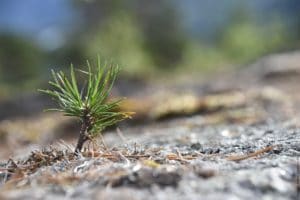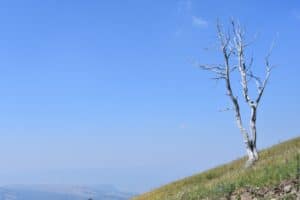
Species have been reported to be moving poleward and upward in mountains as a result of climate change. Evidence of this movement is piling up rapidly, and with every passing year the increasing speed at which it is occurring is also becoming apparent. However, new studies reveal that this species movement is often not as straightforward as it first appears.
 Plants and other sessile organism often show a delayed response to climate change. (Northern Scandes, Norway)
Plants and other sessile organism often show a delayed response to climate change. (Northern Scandes, Norway)
One might think that as the climate warms, so species will follow. The problem is, a species’ reaction to a change in their environment is not always that fast. They often need some time to adjust and to move towards where the climate is now suitable. This delayed reaction is especially true for sessile species, like plants, that depend almost entirely on seed transportation to travel around.
Toward greater understandingThese so-called lags in species distribution shifts are currently not well understood, and even less well accounted for in our predictions of species distributions for the coming centuries. This is why the recent review paper ‘Lags in the response of mountain plant communities to climate change’ published in Global Change Biology (Alexander et al., 2017, arising from a workshop organized by the Mountain Invasion Research Network) provides such timely steps forward for our understanding of these lags.
The paper distinguishes three different types of lags: ‘dispersal lags’ indicate that a species has trouble spreading to higher elevations or towards the poles at the pace of the changing climate, while ‘establishment lags’ result from problems with getting a foothold after arriving in a new environment. The last type of lag – ‘extinction lags’ – indicate that a species fails to disappear from an environment that might have become uninhabitable.
 Species often show an extinction lag, surviving for a certain period in an adverse environment until time catches up with them. (Yellowstone National Park, USA)
Species often show an extinction lag, surviving for a certain period in an adverse environment until time catches up with them. (Yellowstone National Park, USA)
Establishment and extinction lags seem to play a crucial role in shaping species distribution in this dynamic world. For example, closed vegetation in arctic/alpine ecosystems turns out to be very resistant to the establishment of upward moving plants species. Thus, even when low elevation species arrive at higher elevations, they often find highly resistant native vegetation that is hard to overtake. At the same time, many species seem to persist at their lower range edge – even through substantial climatic changes. Again, biotic interactions are likely at play, which are said to be more important than climate at the lower range edge of species.
Hitching a ride
We humans play a critical role here. Surprisingly often, human influence is seen to reduce lags in distribution shifts; humans help with the transportation of species to colder environments, through seeds sticking to clothing for example, and thereby reduce the dispersal lag. Anthropogenic disturbance can reduce the resistance of the receiving community at high elevations as well, making establishment a lot easier for newcomers and thus reducing the establishment lag. In addition, these new invaders might indirectly reduce the extinction lag by out-competing the native community, forcing them to retreat upward.
 Alpine species can often survive in areas at their warmer range edge if they are spared from competition with fast-growing species. (Yellowstone National Park, USA)
Alpine species can often survive in areas at their warmer range edge if they are spared from competition with fast-growing species. (Yellowstone National Park, USA)
So why do we care about these lags? Well, they are critical to understand what will happen to nature in the coming years, with increased climate warming and unlikely-to-cease anthropogenic disturbances looming on the horizon. Ecosystems are already seen to be changing drastically, with novel communities of species sprouting up that may have never lived together before. As species are likely to be lagging behind these changes in their environment, much more change may still be on the way. For a species, lagging behind climate change might indicate an inability to keep up with the changes. Good dispersers, on the other hand, might easily be able to track the climate, only to find the communities they enter lacking the species they usually interact with and desperately need to survive.
Further reading: Alexander et al. (2017) Lags in the response of mountain plant communities to climate change. Global Change Biology 24(2): 563–579.
This post was written by Jonas Lembrechts, a PhD student in mountain ecology at the University of Antwerp, and was originally published on the author’s own blog site, On top of the world.

